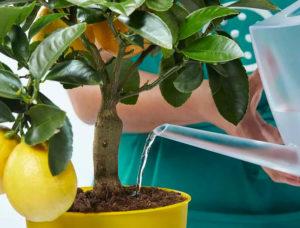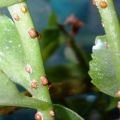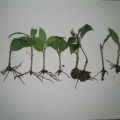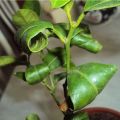How to get rid of scale insects on lemon, means and methods of struggle
Growing citrus crops at home is a laborious and complex process. The representative of the family - indoor lemon - requires compliance with many conditions. One of the dangers for lemon is the spread of a harmful insect on it - the scale insect.
Features of the shield
The scale insects belong to the common family of hemiptera insects. The main difference between this family is the piercing-sucking mouth organs.
Features of the structure of the scale insects:
- the size of the insect can range from 1 to 5 millimeters;
- the body consists of a suction cup and a shield;
- the top layer of the shield is covered with wax.
This structure provides maximum protection to the shield from external influences. They are difficult to remove or destroy. The danger lies in the fact that the shield is removed from the body of the insect, but the parasite, which has adhered to the stem of the plant, remains unharmed.
The way insects breed is by laying eggs. They are distinguished by a high degree of fertility and are able to quickly populate any plant.
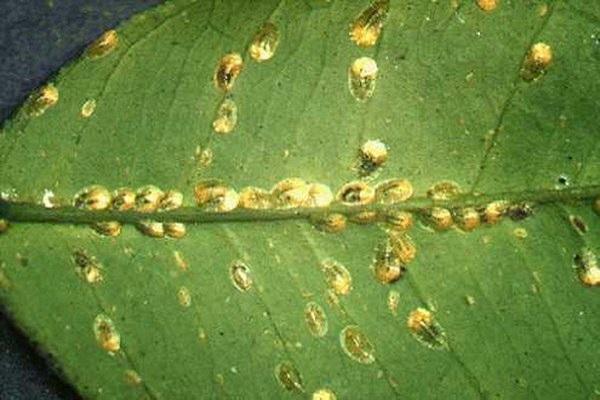
The larvae that emerge from the eggs find a convenient location on indoor lemons, stick to the selected part, and remain motionless for a long time.
The period of existence of females is several months, in this short period of time they are able to lay a hundred eggs.
The stems, on which the scale insects are located, are covered with a sticky, viscous layer; in this environment, the scale insects are especially comfortable.
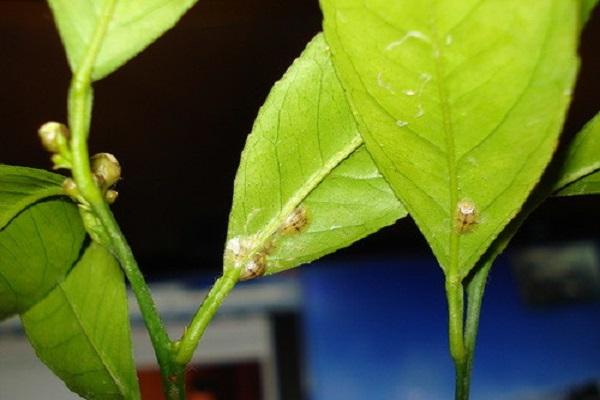
Infection methods
The main ways for the appearance of scale insects on indoor lemons are:
- infestations brought with a plant from a store or neighboring plants;
- spreading scale insects with the help of the wind, if citrus is in the summer on an open veranda.
Information! Damaged and weak plants are susceptible to infection, so they prefer to leave them in the quarantine zone.
Why are scabbards dangerous?
Pests are especially dangerous for lemons:
- feed on plant juice;
- release a sticky liquid that clogs pores;
- interfere with the natural process of photosynthesis;
- promote the spread of fungal infections;
- prevents the supply of nutrients to the plant.
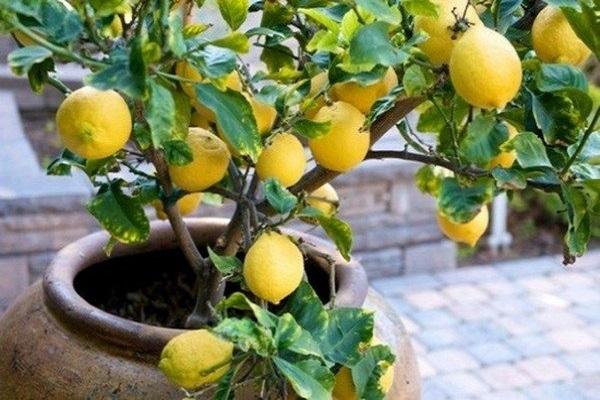
How to tell if a lemon is hit
The appearance of the parasites adapts to the color of the plants, therefore, it is far from immediately possible to notice the appearance of the pest.
The main indicators of infection are:
- small growths on leaves or stems;
- arrangement of small viscous spots on the leaves;
- lemon leaves acquire a yellowish tint at the tips, at the next stage of parasite development, they become yellow-brown.
How to deal with a pest
It takes some time to fight the scabbard on indoor lemon. It is impossible to get rid of parasites within a few days, in some cases you have to use several different methods.
The fact is that the scale insect disguises itself well on the leaves, so gardeners are not always sure that the plants are completely cured.
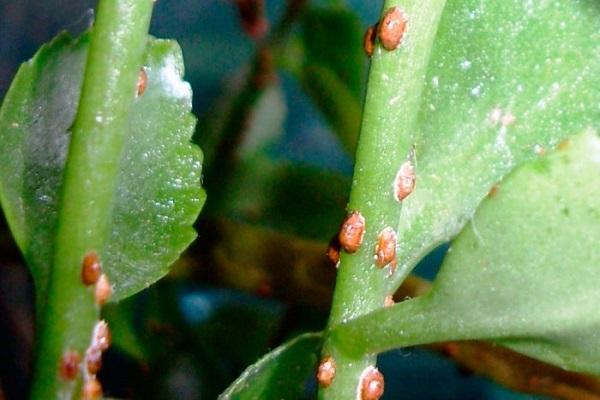
Chemicals
Of the chemical methods, the most common is the use of insecticides or chemicals that have a direct purpose - the destruction of harmful insects.
To destroy the scabbard, agents with different degrees of effect are suitable:
- To destroy the larvae, the drug Fitodermon is used, it is used in the form of a sprayer and begins to act as soon as the insect comes into contact with its elements.
- To eliminate adults, the citrus crown must be treated with systemic insecticides. These include Aktara, Athletic. In addition to processing the crown, the soil is saturated with a solution with the necessary chemical elements, they fall into the vegetable juice, which contributes to the destruction of scale insects.
- To combat larvae and adults, Karbofos solutions are used. The plants are treated several times over two weeks. This is necessary in order to destroy not only the larvae, adults, but also the laid eggs.
One of the disadvantages of treating lemon with insecticides is the inability to carry out such procedures during the fruiting period, as well as the need to create a quarantine period and a quarantine zone for the lemon.
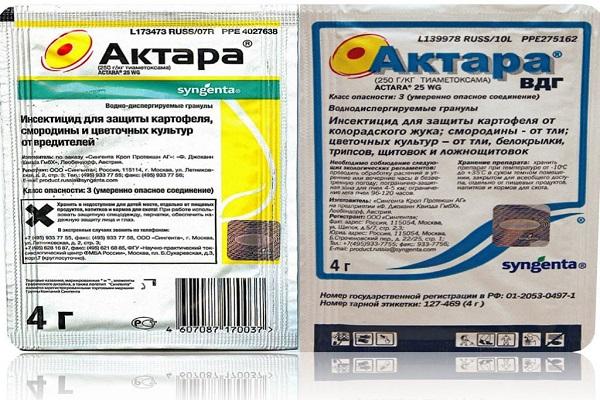
Mechanical
Manual processing of a plant is referred to the category of mechanical methods. To get rid of parasites, use a soapy solution, which is prepared with laundry soap.
For 1 liter of water, take 200 grams of laundry soap. The soap is rubbed on a fine grater. Then it is dissolved in hot water. Leaves and stems are treated with a warm solution with a brush, cotton swabs. Scabbards are removed with special care to prevent them from spreading around the plant in the upper layers of the soil.
Information! To minimize the risk of larvae entering the soil, it is carefully covered with a plastic bag.
Traditional methods
The advantage of folk recipes for removing pests from the surface of a lemon is the ability to use funds during the fruiting or flowering period. They do not harm the plant and are highly effective.
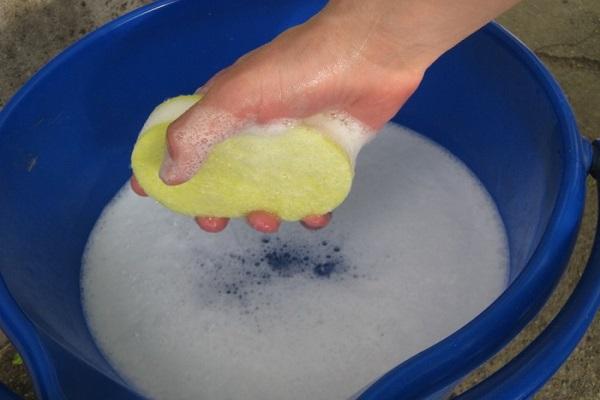
Treatment with tobacco solution
The solution is prepared according to the formula: 2 tablespoons of tobacco per 250 milliliters of water. The liquid is infused for 48 hours, filtered to remove tobacco crumbs, sprayed with a spray bottle. Gardeners advise sprinkling the soil with large-leaved tobacco so that the larvae do not get to the plant through the upper layers.
Using ammonia
The solution is prepared at the rate of 10 milliliters of ammonia per 2 liters of water. The stems and leaves are sprayed with this mixture. Ammonia is effective for getting rid of larvae, egg clutches, but almost no effect on adults.
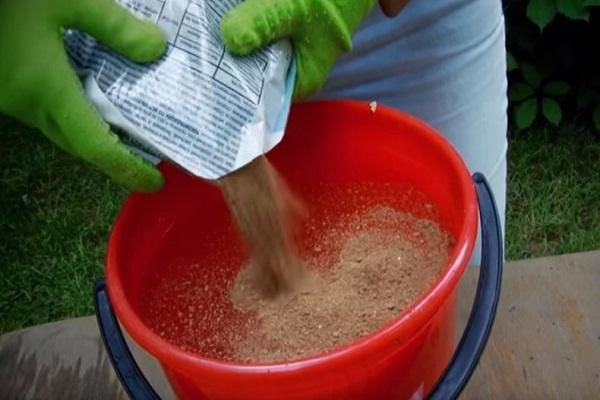
Onion infusion
This is a proven folk remedy that is used not only to get rid of the scabbard, but also to eliminate other dangerous insects. The main disadvantage of the method is considered a pungent unpleasant odor.
To prepare the infusion, the onion is cut into 2 parts, filled with warm water and left for 24 hours to infuse. Leaves are treated with this liquid. It is recommended to wipe the leaves with a cotton pad.
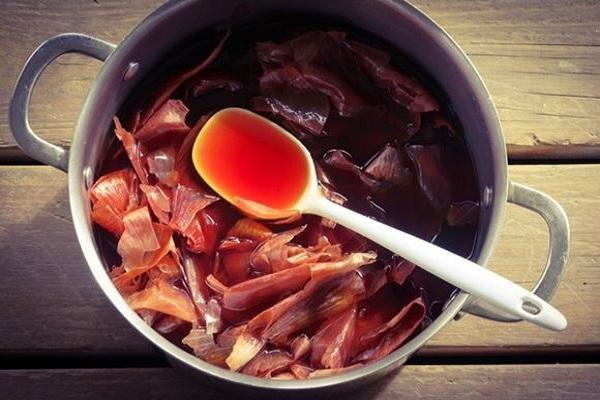
Machine oil
Transformer oil is suitable for the fight. The solution is prepared on the basis of 1 liter of room temperature water and 8 milliliters of oil. Leaves and stems are treated with this liquid once a week.The course of treatments is 3 or 5 procedures.
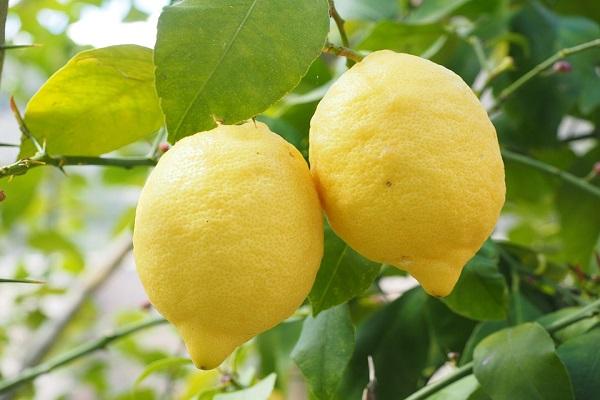
Preventive measures
Healing the lemon after getting rid of the parasites can take a long time. In order to prevent the spread of pests, their further reproduction and the dying off of plant parts, experts advise to follow the rules for caring for indoor citrus fruits:
- pruning of weak non-viable shoots and damaged branches is required;
- keeping recently cured or store-bought plants in the quarantine zone;
- systematic change of the top layer of soil in the pot;
- compliance with humidity, temperature;
- wet cleaning of leaves from dust, dirt;
- airing the room in which the lemon tree is located.
Compliance with the simplest care rules, ensuring optimal conditions for growth will protect the lemon tree from the influence of parasitic insects.
